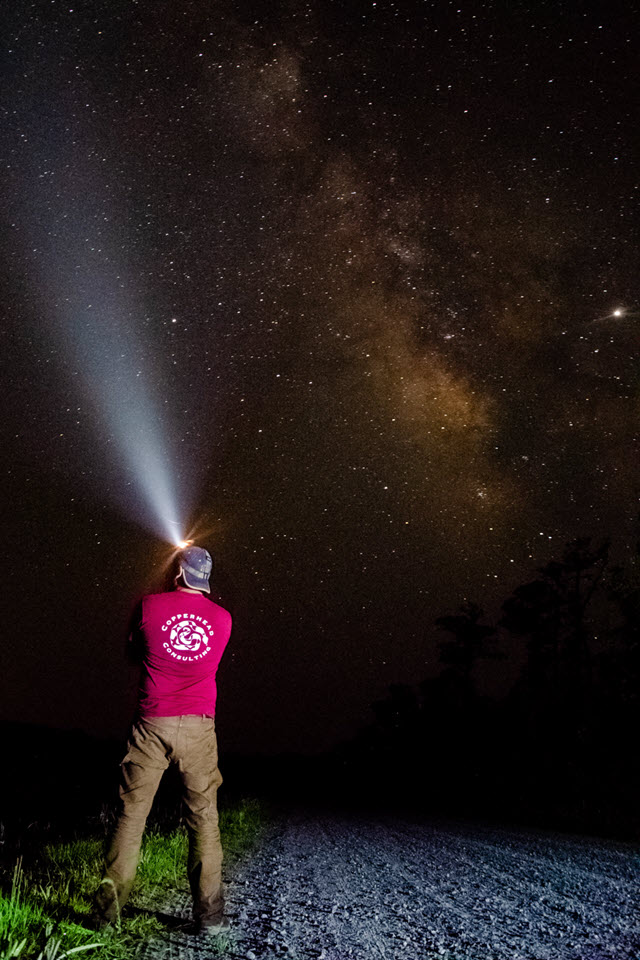Research is an integral part of Copperhead’s ideology. Along with regulatory surveys and projects, we often contribute to the scientific literature and participate in the academic realm of our services.
Bat migration
Copperhead is on the forefront of bat ecology studies. Beginning in 2008 we developed the techniques necessary to actively track migrating Indiana bats (Myotis sodalis) from hibernacula to maternity areas, collecting previously unknown behavior and timing information and locating previously unknown maternity colonies. Using a combination of aerial and ground tracking methods, Copperhead has completed similar migration studies for the federally endangered gray bat (Myotis grisescens), the federally threatened northern long-eared bat (Myotis septentrionalis), and a candidate for listing, the tricolored bat (Perimyotis subflavus). We have also used our aerial tracking knowledge to collect foraging data on all these species as well as the eastern small-footed bat (Myotis leibii), the little brown bat (Myotis lucifugus), and the federally endangered Florida bonneted bat (Eumops floridanus). In addition, we have also conducted fall habitat use and migration tracking of the Indiana bat, northern long-eared bat, and little brown bat.
Artificial bat roosts
During the summer maternity season, the Indiana bat generally roosts under the bark of dead and dying trees. The availability of these roosts is important for the survival of this endangered species. Over the past 12 years, Copperhead has developed a unique artificial roost structure called BrandenBark™ that provides bats with alternative roosting opportunities in areas that lack enough habitat or can be used to replace roosts as mitigation for habitat removal during the regulatory process.
Acoustic lures
Mist-nets are commonly used to capture free-flying bats; however, some bat species are very difficult to capture because of their flight behavior, habitat preferences, and ability to avoid nets. Copperhead has worked with the USFWS along with state and university partners to investigate the effectiveness of using acoustic lures (playbacks of conspecific vocalizations) to increase capture success of bats. While success is highly dependent on species, some such as the Florida bonneted bat, responded extremely well. Prior to our research, this species was only captured once away from a known roost. We captured 15 Florida bonneted bat in our first trials.
Dendrochronology
Along with our forestry work such as timber stand improvement and invasive tree removal, we also engage in research to understand how to manage forests based on their natural history. Our dendrochronology project includes collecting tree ring data from targeted areas of a forest to reconstruct the history of forest disturbance in the area, with a focus on fire history. The goal is to derive an average fire return interval for each focus area and examine how the return interval has changed over time. These data can also be used to generate additional valuable resources such as growth rates, site index, stand age, as well as associated climate data. The culmination of this information will be used to inform forest managers and fire practitioners on the historical impact of fire on a given area.
Mussel Ecology
Copperhead is conducting an in-situ exposure study with Asian clams (Corbicula fluminea) to correlate their survival and growth with water quality in the Upper Paint Lick Watershed. This study will provide information on how nonpoint source pollution is affecting aquatic life within the watershed as well as provide the scientific community more information on enigmatic mussel declines. In 2020, Copperhead was awarded an ecological monitoring and a watershed plan project under a 319(h)-grant provided by the Division of Water, KY Nonpoint Source Pollution Control Program for the Upper Paint Lick Watershed basin. This study will be used in the decision-making process for development of management plans in the watershed and we plan to continue this work in 2022 with native freshwater mussels.



